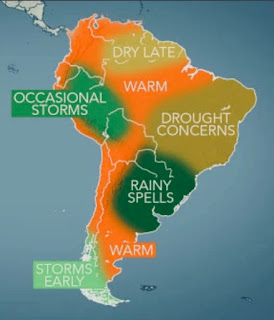Brazil's Main Natural Hazards
Flooding and Mudslides
Brazils main natural hazards are flooding and massive mudslides. Heavy seasonal rains in Brazil lead to flooding and these flash flood events, along with poorly built towns result in mudslides that destroy thousands of dollars worth of infrastructure. According to Brazil’s meteorological agency, INMET, excessive amount of rain is the product of Brazil’s location in the South Atlantic Convergence Zone and is strongest in their warm season. This It causes thunderstorms in the Brazilian rainforest and surrounding areas during the summer. However, the amount of rain that has fallen over the region has doubled the historical rainfall rate that has been recorded by INMET for the past 40 years.
Preparing for Flooding and Mudslides
Flash flooding is a frequent hazard in Brazil. As urbanization increases, more property owners are looking for protection. Urban planning has never been part of Brazil's political agenda, therefore when rain season come around cities are not able to cope. In the mountainous region of Rio de Janeiro many of the cities in the area deal with isolation during rain season because of poor city planning. Hundred of citizens in this region die as a result of mudslides while their neighboring state São Paulo, a prominently wealthier region, deals with little to no deaths. This is one of the many examples of how poorly Brazils government distributes its money throughout the country.
One of the first steps Brazil must take when managing the results of floods and mudslides is helping the poorer regions rebuild their homes in a way that will help them be prepared for these events. Their government only sets out plans to deal with the outcome, rather than plan and prevent. The idea of "long-term planning" is not often found in Brazils political dictionary. They focus more on "short-term" public works. The Supreme Court has showed some effort to set out and follow an urban plan. They have divided their subject axis into 4 sections
• Prevention – Constructions related to the natural disasters risk reduction - Development Acceleration Program.
• Mapping – Mapping of areas with high risk of landslide, flood and
rushing stream of water.
• Monitoring and alert – Observation equipments and situation rooms
to improve the weather and hydrological forecasts and warnings.
Regions of Brazil
Every part of Brazil deals with its own natural hazards, from droughts to flooding. When deciding where to live in Brazil it is up to you to decide what you rather deal with. Majority of my family is spread across different regions of Brazil. My aunt lives in the state of Ceará, where she says the experience very minimal flooding. Ceará is located in the northeastern part of Brazil, has a mountainous interior and an Atlantic coastline line. The average temperature for this region varies from 75°F to 87°F and rarely goes below 73°F or above 89°F. This is a warm region of Brazil that does occasionally experience droughts and flooding bur not near to the extend of the South and Southeast regions. These areas along with some parts of the North have to manage not only river flooding, coastal flooding, and urban flooding, but it also has to manage tsunamis and landslides.
Sources:
http://thinkhazard.org/en/report/37-brazil/WF
https://www.connective-cities.net/secure_doc/user_upload/Presentation_Cologne_Oliveira.pdf
https://www.aljazeera.com/blogs/americas/2011/01/3035.html
https://www.nesdis.noaa.gov/content/floods-brazil-cause-mudslides-and-property-damage
https://www.theguardian.com/global-development/poverty-matters/2011/feb/02/brazil-floods-urban-planning
https://www.accuweather.com/en/weather-news/2017-south-america-spring-forecast-drought-to-persist-in-eastern-brazil-frequent-storms-to-pose-flood-risk-to-chile-argentina/357557




Hi Leti! This is very well done! It was very interesting to learn about the impact of flooding and mudslides on Brazil. I have to agree with you when it comes to deciding where to live. Every area you live in has its risks, so might as well live where you're going to enjoy living! Thank you again for post, and hope you had a great semester!
ReplyDeleteHey Leti! First off I just wanted to add that I extremely loved your blog and it was more than interesting to read! A similarity I noticed between our chose countries of Brazil and Nepal is their mitigation efforts consisting of the emphasis on infrastructure durability and how both of our countries are in the progress of building them. Both of our countries deal with flash flooding and the only true way to deal and prevent casualties and destruction from that is with constructions and mapping to where those constructions should go. Also forecasting is also a new vocal point on both of our nations plannings in order to predict and estimate when a threat is possibly nearby to warn its i inhabitants. Cheers!
ReplyDeleteThank you for taking this class with us. I hope you enjoyed while learning about natural hazards in the world!
ReplyDelete